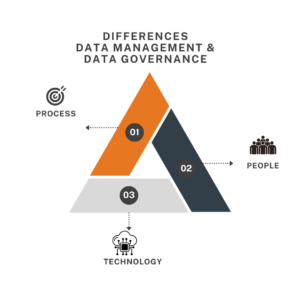 For effective data processing within an organization, Data Governance and Data Management are closely connected disciplines. Data Governance establishes policies and guidelines for data usage, while Data Management implements and executes these policies. The differences in processes, the roles of involved individuals, and the technology used emphasize the complementary nature of both disciplines in achieving an organization’s data-related objectives. In this blog, we will delve deeper into this.
For effective data processing within an organization, Data Governance and Data Management are closely connected disciplines. Data Governance establishes policies and guidelines for data usage, while Data Management implements and executes these policies. The differences in processes, the roles of involved individuals, and the technology used emphasize the complementary nature of both disciplines in achieving an organization’s data-related objectives. In this blog, we will delve deeper into this.
Difference #1: Processes
Data Governance (DG) primarily addresses how organizations should make decisions regarding their own data usage. DG establishes guidelines translated into key processes. Key processes within DG include:
- Setting up data quality controls to ensure the accuracy and consistency of data.
- Defining policies regarding data access (who can access which data, who can modify, view, etc.).
- Ensuring compliance with both external and internal (i.e., organizational) regulations, such as privacy and data security standards.
- Creating and maintaining a ‘Business Glossary,’ a type of dictionary aiming to establish shared understanding within an organization of the terminology and definitions used in data.
On the other hand, Data Management (DM) is concerned with the practical implementation of the guidelines established by DG, focusing on how organizations use data. Key DM processes include:
- Data transformations (ensuring data remains consistent in format for effective use).
- Data storage, including managing data warehouses, data lakes, and other storage solutions.
- Data exploration for addressing operational and analytical use cases, including queries, reporting, and data analysis.
- Data management processes aligning with the guidelines from the DG framework (ensuring data is managed and used in accordance with DG policies).
Difference #2: People
Traditionally, DG is considered a function involving both Business and IT teams. Implementing DG often requires involvement from business managers, data domain owners, and other Business stakeholders who then collaborate with IT teams to establish data access policies, define data quality standards, and ensure compliance with legal requirements regarding data.
Conversely, DM is primarily focused on execution, involving the practical implementation of the DG framework and the influence of an organization’s objectives. Execution typically requires more technical roles such as data engineers, data architects, and Database Administrators (DBAs), responsible for data storage, access control, and other technical aspects.
Difference #3: Technology
DG relies on specific tools to document and enforce the organization’s rules and guidelines. These tools are designed to ensure proper management of data assets and often include:
- Data dictionaries and business glossaries, providing definitions and context to the used data terminology within an organization.
- Data catalogs allowing users to discover and understand available data assets.
On the other hand, DM focuses more on the technical aspects of data processing, storage, manipulation, and exploration. The technology used in DM includes solutions for data storage, data integration tools, frameworks for data processing, and platforms for data analysis. These tools aim to make data accessible and usable for various operational and analytical use cases.
Tentive Data Management Consultants
The consultants at Tentive have extensive experience in both data governance and data management and are ready to support your organization in this area. If your organization is interested in getting started, we invite you to contact us for a no-obligation conversation. We are available for further discussion.



